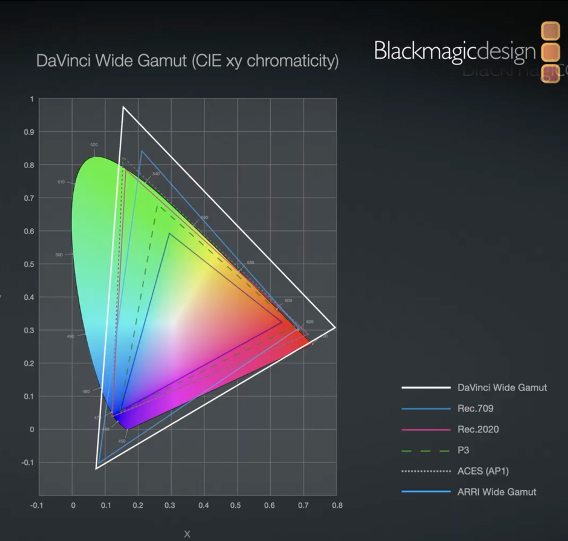Blackmagic Design marries hardware and software to enhance editing and compositing tasks.
Blackmagic Design is not the kind of company to let a worldwide pandemic and recession go to waste. The company kept a low (for them) profile throughout the NAB time frame and now arrives with a revamped DaVinci Resolve with new tools and companion hardware.
In the demo available on the Blackmagic Design site, CEO Grant Petty took the controls himself to demonstrate the new tools for Resolve 17 and he kicked off with a focus on the color grading tools in Resolve. There is a lot to love. The company says there are 100 new features and 200 improvements. I’m pretty sure Petty demonstrated each one in his 1.5+ hour demo.
New tools include HDR grading, redesigned controls, and an AI-based magic mask.
 |
| Cameras can capture HDR, some displays support the wider color gamut to display HDR, and the new DaVinci Resolve 17 gives users the controls to edit and output HDR, thus pushing HDR content creation closer to the mainstream. (Source: Blackmagic Design) |
Color Grading was an important focus for DaVinci with this release. The company is further accommodating the arrival of wide-gamut displays and HDR cameras at attractive prices. The company has added automatic features and fine-tuning. DaVinci has made considerable improvements to its color editing tools. New HDR controls provide more stops by splitting the image into tonal regions including dark, shadow, light, highlight, specular, and global.
DaVinci offers an expanded color space and gamma settings that provide a universal internal working color space. It’s larger than what cameras can capture exceeding BT.2020, ARRI wide gamut, and ACES AP1.
 |
| DaVinci’s expanded color space gives artists more room to work and provides headroom for all cameras. |
The new color warper adds even more control through a 3D mesh-based tool to allow adjustments of color and luminance. Users can get more fine-tuned control over the HSL curve for HDR media.
The Magic Mask is a nice AI-enabled feature that lets users easily select part of a frame, say a character or object, to be masked allowing the object or the surroundings to be adjusted. The technology takes advantage of Blackmagic’s Neural Engine, which leverages GPU power. To make a selection, it’s not necessary to trace the whole shape; it’s enough to identify a representative region and the software does the rest.
For Resolve’s Fusion compositing tools, Blackmagic lets users save their compositions as templates to use on the edit or cut pages. Markers are shared with edit and cut pages to speed workflow. Animations can be cued to audio waveforms for precise animations. Animation curve modifiers enable users to automatically retime animations when they’re changed in edit.
There are 27 new GPU accelerated effects on the Fusion page including noise reduction and sharpening. Node view bookmarks help users navigate through large compositions and vertical layouts are supported in the node editor.
Blackmagic has enabled the multi-user collaboration tools previously available in DaVinci Resolve Studio.
The free version of Resolve 17 has gotten new multi-user collaboration tools previously only available in the Studio version of Resolve, which is available for $295.
New hardware companions
Blackmagic is much more interested in software when it’s accompanied by hardware. The company has forged strong links between cameras and its software tools because, primarily, the company sells hardware.
The company has developed a compact new keyboard for DaVinci Resolve’s cut page that enables fast two-handed workflows with controls for each edit function.
 |
| For an unspecified limited time, the new Blackmagic Speed Editor will be available free with purchases of Resolve Studio through channel vendors. Since the Editor costs $295 and the software is $295, it’s a wash. (Source: Blackmagicdesign.com) |
Blackmagic’s Fairlight tools integrated with Resolve have also gotten new updates and new hardware options enabling customers to build any size console their heart desires.
Fairlight, which was acquired by DaVinci in 2016, supports advanced sound editing including native MDA (multi-dimensional audio, object-based) sound tools and 5.1, 7.1, and Dolby Surround. It was developed for studio work and enables live recording session tools. Fairlight has gotten support for mouse and keyboard in addition to its control panels and, also, Black Magic has introduced compact control panels and modular units to allow its customers to build a setup that will fit whatever environment they have.
 |
| Grant Petty shows off the new Fairlight Desktop Console and the ability to add an LCD monitor to view a graphical interface with audio status and metering. (Source: Blackmagic presentation) |
The Fairlight Desktop Console is a portable control surface with 12 touch-sensitive faders, and built-in LCDs above the channels for pan and effects control and full automation control. The console has an HDMI interface to connect a monitor for an expanded graphical interface. In addition, Black Magic is enabling customers to add any HDMI or SDI display for use with Fairlight consoles with the addition of an HDMI Monitor Interface.
Blackmagic notes that their Fairlight customers often build their own furniture for the editing suite so now they can add their own display. Also, the company has additional fixtures to let customers mix and match consoles.
With this release, Black Magic has ticked off several competitive features. It has additional AI capabilities and GPU powered effects. The edit page provides access to transitions, effects, and titles, which enable artists to stay in the flow and work faster. Fairlight can support up to 2000 tracks, additional audio libraries are accessible from within the Fairlight audio page. Fairlight has also added ADR (automatic dialog replacement) with live recording. For narrative content, the list tab has character names and dialog.
This just in…
Blackmagic Design just announced Universal support for Apple’s new M1 processor, which they’re making available as a Resolve 17.1 beta.
What do we think?
Resolve is trying to span the user base from enthusiasts, streamers, broadcasts, features, and commercial work. With their free version, Resolve has gotten an infusion of new users. The company has claimed 2 million users which is in line with what Apple and Adobe have claimed. Actual numbers are harder to nail down when you’re talking about free software, but DaVinci had a professional user base when Blackmagic acquired it. The company is adding to its power with support for cameras, mixers, and accelerators.
The battle for users among Adobe, Apple, Avid, and Black Magic, Black Magic is more competitive than ever but Blackmagic’s free and low-cost perpetual license is speaking to a lot of users.






